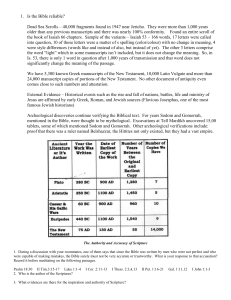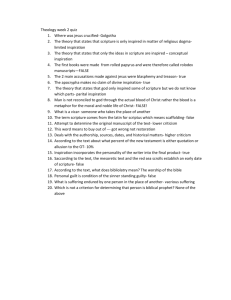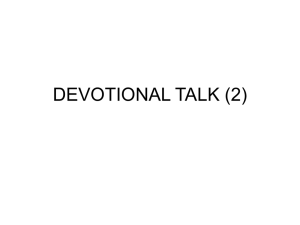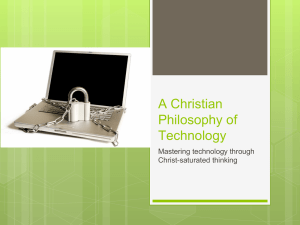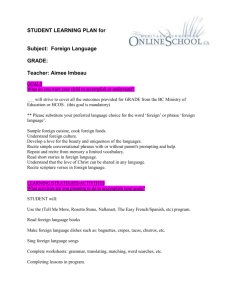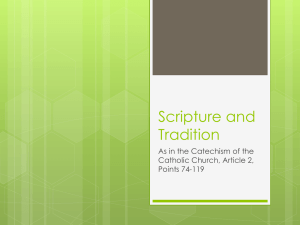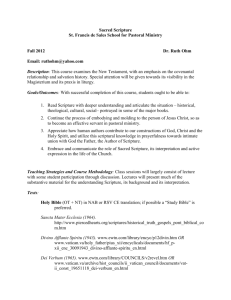Old Testament – Class #2
advertisement
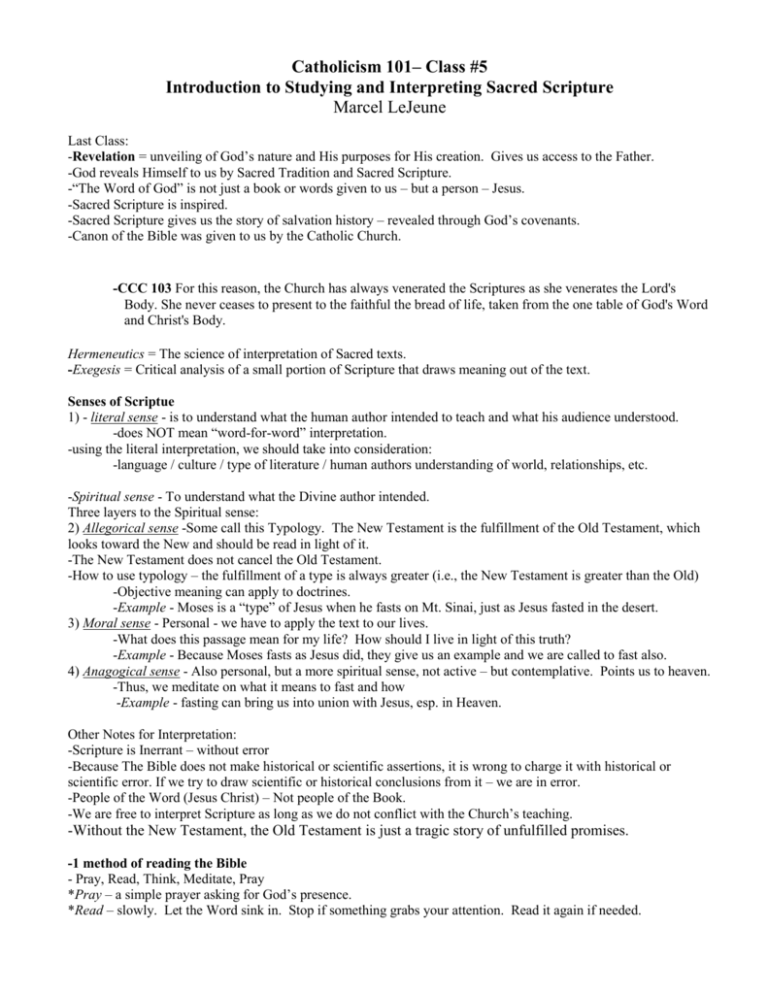
Catholicism 101– Class #5 Introduction to Studying and Interpreting Sacred Scripture Marcel LeJeune Last Class: -Revelation = unveiling of God’s nature and His purposes for His creation. Gives us access to the Father. -God reveals Himself to us by Sacred Tradition and Sacred Scripture. -“The Word of God” is not just a book or words given to us – but a person – Jesus. -Sacred Scripture is inspired. -Sacred Scripture gives us the story of salvation history – revealed through God’s covenants. -Canon of the Bible was given to us by the Catholic Church. -CCC 103 For this reason, the Church has always venerated the Scriptures as she venerates the Lord's Body. She never ceases to present to the faithful the bread of life, taken from the one table of God's Word and Christ's Body. Hermeneutics = The science of interpretation of Sacred texts. -Exegesis = Critical analysis of a small portion of Scripture that draws meaning out of the text. Senses of Scriptue 1) - literal sense - is to understand what the human author intended to teach and what his audience understood. -does NOT mean “word-for-word” interpretation. -using the literal interpretation, we should take into consideration: -language / culture / type of literature / human authors understanding of world, relationships, etc. -Spiritual sense - To understand what the Divine author intended. Three layers to the Spiritual sense: 2) Allegorical sense -Some call this Typology. The New Testament is the fulfillment of the Old Testament, which looks toward the New and should be read in light of it. -The New Testament does not cancel the Old Testament. -How to use typology – the fulfillment of a type is always greater (i.e., the New Testament is greater than the Old) -Objective meaning can apply to doctrines. -Example - Moses is a “type” of Jesus when he fasts on Mt. Sinai, just as Jesus fasted in the desert. 3) Moral sense - Personal - we have to apply the text to our lives. -What does this passage mean for my life? How should I live in light of this truth? -Example - Because Moses fasts as Jesus did, they give us an example and we are called to fast also. 4) Anagogical sense - Also personal, but a more spiritual sense, not active – but contemplative. Points us to heaven. -Thus, we meditate on what it means to fast and how -Example - fasting can bring us into union with Jesus, esp. in Heaven. Other Notes for Interpretation: -Scripture is Inerrant – without error -Because The Bible does not make historical or scientific assertions, it is wrong to charge it with historical or scientific error. If we try to draw scientific or historical conclusions from it – we are in error. -People of the Word (Jesus Christ) – Not people of the Book. -We are free to interpret Scripture as long as we do not conflict with the Church’s teaching. -Without the New Testament, the Old Testament is just a tragic story of unfulfilled promises. -1 method of reading the Bible - Pray, Read, Think, Meditate, Pray *Pray – a simple prayer asking for God’s presence. *Read – slowly. Let the Word sink in. Stop if something grabs your attention. Read it again if needed. *Think – Is there: an example for me to follow? an error or mistake for me to avoid? a command for me to obey? a question for me to answer? a promise for me to accept? a sin for me to repent of? a teaching for me to believe - about God, about life, about the world? *Meditate – try to place yourself in the passage using your imagination. *Pray – a short prayer asking God to help you grow closer to His Will in whatever way you feel called. How to read the Bible – a 2nd Way Vatican II gives us three criteria for the interpretation of Scripture (repeated in CCC 111-114) 1. Be especially attentive "to the content and unity of the whole Scripture." 2. Read the Scripture within "the living Tradition of the whole Church." 3. Be attentive to the analogy of faith. – See with eyes of faith… 3 Criteria for Interpretation + 4 Senses of Scripture using Genesis 2:4 – 3:24 3 Criteria for Interpreation: 1 – Content and unity of Scripture -Matt 19:3 – 12 2 – living tradition of the Church -Theology of the Body / Catechism -Church Fathers: -"Every soul, then, by reason of its birth, has its nature in Adam until it is born again in Christ; moreover, it is unclean all the while that it remains without this regeneration; and because unclean, it is actively sinful, and suffuses even the flesh (by reason of their conjunction) with its own shame. " Tertullian,On the Soul,40(A.D. 208) "Everyone in the world falls prostrate under sin. And it is the Lord who sets up those who are cast down and who sustains all who are falling. In Adam all die, and thus the world prostrate and requires to be set up again, so that Christ all may be made to live." Origen,Homilies on Jeremias,8:1(post A.D. 244) 3 – Analogy of faith -Can we see God’s work in creation? -How do we balance what we know about God’s creative work and science? 4 Senses of Scripture 1 - Literal sense -What did the human author intend to teach and how did his audience understand him? -What 2 - Allegorical sense -What “types” do we see here? (think Adam and Eve) 3 - Moral sense -How does this passage apply to your daily life? 4 - Anagogical sense -How does this apply to your spiritual life (as a foretaste of heaven)?

